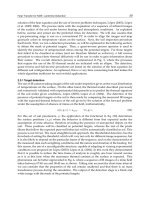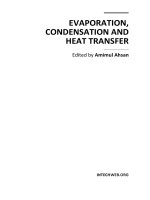Evaporation Condensation and Heat transfer Part 2 docx
Bạn đang xem bản rút gọn của tài liệu. Xem và tải ngay bản đầy đủ của tài liệu tại đây (3.13 MB, 40 trang )
αdP
TP,f
/dz [kPa/m]
heat flux [ kW/m
2
]
dP
TP,f
/dz [kPa/m]
vapor quality
dP
TP,f
/dz
pred
[kPa/m]
dP
TP,f
/dz
exp
[kPa/m]
dP
TP,f
/dz
pred
[kPa/m]
dP
TP,f
/dz
exp
[kPa/m]
dP
TP,f
/dz
pred
[kPa/m]
dP
TP,f
/dz
exp
[kPa/m]
dP
TP,f
/dz
pred
[kPa/m]
dP
TP,f
/dz
exp
[kPa/m]
dP
TP,f
/dz
pred
[kPa/m]
dP
TP,f
/dz
exp
[kPa/m]
dP
TP,f
/dz
pred
[kPa/m]
dP
TP,f
/dz
exp
[kPa/m]
f
X
2
f
vapor quality
2
f
X
dP
TP,f
/dz
pred
[kPa/m]
dP
TP,f
/dz
exp
[kPa/m]
TP
[ kW/m
2
K]
vapor quality
TP,Pred
/ h
TP,exp
Vapor quality
h
TP,Pred
/ h
TP,exp
Vapor quality
h
TP,Pred
/ h
TP,exp
Vapor quality
h
TP,Pred
/ h
TP,exp
Vapor quality
h
TP,Pred
/ h
TP,exp
Vapor quality
h
TP,Pred
/ h
TP,exp
Vapor quality
TP
[ kW/m
2
K]
vapor quality
h
TP
[ kW/m
2
K]
vapor quality
h
TP,Pred
/ h
TP,exp
Vapor quality
Flow direction
Length of elongated bubble [ m]
Time [ sec]
Length of elongated bubble [ m]
Time [ sec]
μ μ
Experimental and Computational Study of Heat
Transfer During Quenching of Metallic Probes
B. Hernández-Morales
1
, H.J. Vergara-Hernández
2
,
G. Solorio-Díaz
3
and G.E. Totten
4
1
Universidad Nacional Autónoma de México,
2
Instituto Tecnológico de Morelia,
3
Universidad Michoacana de San Nicolás de Hidalgo,
4
Texas A&M University,
1,2,3
México
4
USA
1. Introduction
Heat transfer from hot bodies such as steel, aluminum and other metals is vitally important
for a wide range of industries such as chemical, nuclear and manufacturing (including steel
hardening) industries. Hardening of steels (so-called martensitic- or bainitic-hardening)
requires preheating (austenitizing) of the part to temperatures in the range of 750-1100 °C,
from which the steel is quenched (i.e., rapidly cooled) in a defined way to obtain the desired
mechanical properties such as hardness and yield strength. Most liquid quenchants used for
this process exhibit boiling temperatures between 100 and 300 °C at atmospheric pressure.
When parts are quenched in these fluids, wetting of the surface is usually time dependant,
which influences the cooling process and the achievable hardness (Liscic et al., 2003).
Heat transfer research related to cooling has been the source of fundamental studies since
the early work by Fourier (Fourier, 1820). These early studies were typically performed by
hot-wire anemometry (King, 1914; Russell, 1910). One of the first to report the results of
fundamental heat transfer studies for the quenching of metals such as steel using cooling
curve analysis (time vs. temperature curves) was Benedicks who utilized 4-12 mm diameter
x 15-50 mm cylindrical carbon steel probes in his now-classic work (Benedicks, 1908). The
advantage of using probes larger in diameter than thin platinum wire used for hot-wire
anemometry tests is that it is possible to more easily measure thermal gradients through the
cross-section upon cooling and to view surface cooling mechanisms. Benedicks work
involved cooling hot steel (1000 ºC) in water at 4.5 – 16 ºC and in addition to cooling time
from 700 ºC – 100 ºC, effects of the ratio of mass/surface area on cooling time were
evaluated.
In 1920, Pilling and Lynch measured the temperature at the center of 6.4 mm dia x 50 mm
cylindrical carbon steel probes cooled (quenched) from 830 ºC into various vaporizable
liquids (Pilling & Lynch, 1920). From this work, they identified three characteristic cooling
mechanisms, so-called: A, B and C-stage cooling which are currently designated as film
boiling, nucleate boiling and convective cooling, based on the cooling time-temperature and
Evaporation, Condensation and Heat Transfer
50
cooling rate – temperature profiles. Scott subsequently developed graphical methodology
for estimating heat transfer coefficients from the centerline cooling curves of steel probes
(Scott, 1934).
At approximately the same time, French reported cooling curve results measured at the
surface and center of cylindrical and spherical probes (12.7 – 280 mm dia) quenched into a
series of vaporizable liquids from 875 ºC (French, 1930). In addition to studying the effect of
agitation, oxidation and surface roughness on cooling velocity, French performed
photographic examination of the different cooling mechanisms occurring during the quench
processes. These were among the very first pictorial studies illustrating surface wetting
differences throughout the quenching process. Similar photographic studies were
performed by Sato for examining the effect of facing materials on water quenching processes
(Sato, 1933).
Speith and Lange used 10-20 mm cylindrical and spherical copper probes and spherical
silver probes to examine quenching processes (Speith & Lange, 1935). The cooling media
included tap water, distilled water and rapeseed oil. In addition to cooling curve behavior,
they also studied the boundary surface conditions and vapor film formation and breakage
on the quenching process using schlieren photography.
Using a 25.4 mm spherical silver probe with a center thermocouple and another exposed at
the surface of the ball, T.F. Russell obtained time-temperature cooling curves after
quenching in petroleum oil (Russell, 1939). In addition, photographs were taken throughout
the quenching process and, like Speith and Lange, showed that that the vapor film which is
formed initially on the surface breaks down at a characteristic point. However, Russell did
show that the breakage of the vapor film did not occur uniformly on the entire surface.
Instead, he observed that the bottom of the probe took longer to reach the characteristic
transition temperature than did the sides of the ball indicating non-uniform film formation
and rupture over the entire surface of the ball during the quenching process.
Tagaya and Tamura were the first to perform a detailed correlation between surface cooling
curves obtained with a 10 mm dia x 300 cylindrical silver probe with a surface thermocouple
and movies of the quenching process (cinematographic methods) of the observed cooling
mechanisms as they relate to surface wetting processes during quenching (Tagaya &
Tamura, 1952). By using a silver probe with a surface thermocouple, they identified four
stages of cooling which included the shock-film boiling process that preceeds formation of
full-film boiling. Other workers in the field have subsequently used cinematography to
study surface heat transfer mechanisms during quenching (Kobasko & Timchenko, 1986;
Lainer & Tensi, 1996; Tensi & Lainer, 1999; Narazaki et al., 1999).
Ben David et al. have described the rewetting process and the characteristic temperature
where this occurs as: “Rewetting of hot surfaces is a process in which a liquid wets a hot
solid surface by displacing its own vapor that otherwise prevents contact between the solid
and liquid phases. When a liquid contacts a sufficiently hot surface it comes to a boiling
point, and a vapor film, which separates the liquid from the surface, is generated. As the
surface cools off, the vapor film reaches a point where it can no longer be sustained. At this
point, the vapor film collapses and surface liquid contact is reestablished. This phenomenon
is called re-wetting or quenching” (Ben David et al., 1999). The temperature at the solid-
liquid-vapor contact line is designated as the rewetting temperature or Leidenfrost
temperature (Frerichs & Luebben, 2009). Specific knowledge of the rewetting process is
especially important because the highest heat transfer coefficient occurs during rewetting.
Experimental and Computational Study of Heat Transfer During Quenching of Metallic Probes
51
G. J. Leidenfrost described the wetting process about 250 years ago (Leidenfrost, 1966).
Literature describes Leidenfrost temperature-values for water at atmospheric pressure
between 150 and 300°C (Yamanouchi, 1968; Duffly & Porthouse, 1973; Kunzel, 1986; Hein,
1980). The Leidenfrost Temperature is influenced by a variety of factors, some of which
cannot be quantified precisely even today.
For a nonsteady state cooling process, the surface temperature at all parts of the workpiece
is not equal to the Leidenfrost Temperature at a given time. When the vapor blanket (or film
boiling) collapses, wetting begins by nucleate boiling due to the influence of lateral heat
conduction (relative to the surface) (Ladish, 1980). This is due to the simultaneous presence
of various heat transfer conditions during vapor blanket cooling (or film boiling [FB]),
nucleate boiling [NB], and convective heat transfer [CONV] with significantly varying heat
transfer coefficients α
FB
(100 to 250 kW m
-2
K
-1
); α
NB
(10 to 20 kW m
-2
K
-1
), and α
CONV
(ca. 700
W m
-2
K
-1
). Figure 1 schematically illustrates the different cooling phases on a metal surface
during an immersion cooling process with the so-called "wetting front," w, (separating the
"film boiling phase" and the "nucleate boiling phase") and the change of the heat transfer
coefficients, α, along the surface coordinate, z, (mantle line). In most cases during immersion
cooling, the wetting front ascends along the cooling surface with a significant velocity, w,
whereas during film cooling the wetting front descends in the fluid direction (Liscic et al.,
2003; Stitzelberger-Jacob, 1991).
Fig. 1. Wetting behavior and change of heat transfer coefficient (
α
) along the surface of a
metallic probe: (a) immersion coling, (b) film cooling (Liscic et al., 2003; Stitzelberger-Jacob,
1991).
Evaporation, Condensation and Heat Transfer
52
A rewetting process for a heated cylindrical test specimen which was submerged in water is
shown in Figure 2 (Tensi & Lainer, 1997; Tensi, 1991; Tensi et al., 1995). Because of the
different wetting phases on the metal surface (and the enormous differences of their values
of αFB, αNB, and αCONV) the time dependant temperature distribution within the metal
specimens will also be influenced by the velocity and geometry of the wetting front (for
example, circle or parabolic-like) as well as geometry of the quenched part. Tensi et al.
(Tensi et al., 1988) and Canale and Totten (Canale & Totten, 2004) have reported that the
degree of non-uniformity of this rewetting process may be sufficiently significant that it will
lead to quenching defects such as non-uniform hardening, cracking and increased
distortion. Therefore, the understanding and quantification of surface rewetting during
quenching by immersion in vaporizable fluids is critically important.
Fig. 2. Cooling process illustrating the transition of the three cooling mechanisms – film
boiling (FB), nucleate boiling (NB), convective cooling (CONV) - during immersion cooling
of a cylindrical 25 mm dia × 100 mm CrNi-steel test specimen quenched from 850°C into
water at 30°C with an agitation rate of 0.3 m/s (Tensi, 1991).
Various methods have been used to quantify the rewetting kinematics of different
quenching processes. One of the earlier methods was to place surface, or near surface
thermocouples at known positions on a probe surface (Tensi et al., 1995; Narazaki et al.,
1999). Although any probe shape could be employed, most typically a cylindrical probe is
used. However, it is important to note that when cylindrical probes are used, probe shape of
the bottom surface is important (Tensi & Totten, 1996). It has been shown by various
workers that perfectly flat surfaces are often not preferred because of their potential impact
on the stability of the film-boiling process and subsequent transition to nucleate boiling; the
so-called edge effect (Narazaki et al., 1996). Recently, a preferred probe design has been
proposed for use in studying rewetting kinematics of immersion quenching processes
(Vergara-Hernández & Hernández-Morales, 2009).
Tensi et al. have used electrical conductance measurements to quantify wetting kinematics
for classification of the overall rewetting processes that may be encountered and for
subsequent modeling work (Tensi et al., 1988). This is based on the fact that the electrical
conductance increases significantly as the vapor blanket formed during film boiling
ruptures, which is followed by the nucleate boiling process where there is fluid contact at
the metal-quenchant interface. The electrical conductance increases as the coverage of the
surface with boiling quenchant increases (Totten & Tensi, 2002).
Experimental and Computational Study of Heat Transfer During Quenching of Metallic Probes
53
Tkachuk et al. have shown the importance of surface wetting properties of both the
basestocks used to formulate oil quenchants and the effects of a wide range of different
additives on surface wetting, especially as it relates to cooling rates (Tkachuk et al., 1989;
Tkachuk et al., 1986). Not unexpectedly, as the wetting properties improve, the heat
extraction capability increases resulting in higher cooling rates. However, these
measurements were limited to room temperature and they did not describe the rewetting
process during quenching using these fluid formulations. More recent work by Jagannath
and Prabhu has however addressed many of these shortcomings by utilizing dynamic
measurements on the quenching surface (Jagannath & Prabhu, 2009). While they do provide
a dynamic measure of overall wetability, such measurements do not provide any
quantification of the movement of the wetting front during the immersion quench.
The method of choice to study surface rewetting process involves quantitative
cinematography. Various workers have discussed experimental approaches to examining
surface rewetting using different probe designs and experimental processes to study
immersion quenching in vaporizable fluids (Lainer & Tensi, 1996; Tensi & Lainer, 1999;
Hernández-Morales et al., 2009; Lübben et al., 2009; Frerichs & Lübben, 2009). These
measurements have been invaluable in providing more realistic assessments in the
modeling of heat flux, thermal gradients and residual stresses during quenching such as the
work reported by Loshkaroev et al. (Loshkaroev et al., 1994).
Given the importance of carefully monitoring the advance of the wetting front and deriving
quantitative information about heat extraction during forced convective quenching, in this
chapter, we describe detailed computational and experimental work to asses the usability of
probes of different geometries. Also, results of wetting front kinematics and heat extraction
obtained with a conical-end cylindrical probe are presented.
2. Experimental work
The experimental apparatus is shown in Figure 3. The water in the main container is drawn
with a ¼ HP pump and flows through a 90° elbow followed by a vertical plexiglass tube (44
mm I.D.). The water flowrate is set with a rotameter which is placed before the 90° elbow.
After impacting the probe, the water is discharged in a secondary container. The desired
water temperature is achieved with electrical heaters placed within the main container; the
water temperature control was manual.
From PIV (Particle Image Velocimetry) measurements conducted at several distances from
the elbow it was found that the velocity profile was not fully developed until a position of
1.50 m along the vertical section of the plexiglass tube (Vergara-Hernández & Hernández-
Morales, 2009). Thus, the probe tip was always located at 1.70 m from the elbow. The probe
was heated in an electric furnace (in stagnant air) up to a temperature of 915 °C such that the
temperature at the start of the quench was close to 900 °C in all experiments. To ensure a
quick and controlled descent of the probe into the quench bath, the probe was attached to a
steel lance which in turns was fitted to a moving spreader.
Three probe geometries were considered: 1) flat-end cylinder, 2) hemispherical-end cylinder
and 3) conical-end cylinder. The probes were machined from AISI 304 stainless steel stock
bar and instrumented with 1/16”, Inconel-sheathed, type K (see Figure 4). The
thermocouples were press-fitted into position. To keep water to enter into the space between
the thermocouple and the bore wall, the top surface of the probe was covered with high
temperature cement (Omega, model Omega 600).









